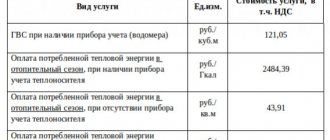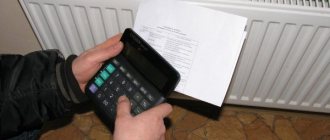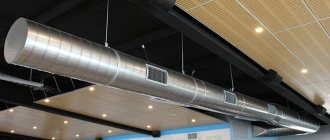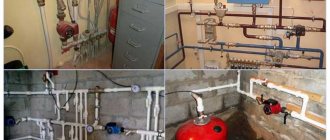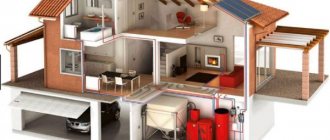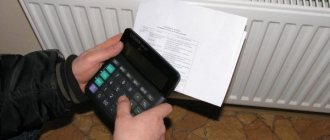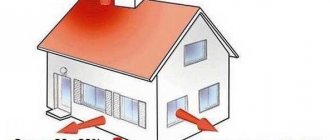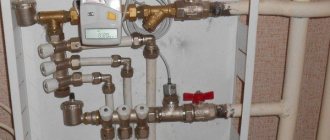What is this unit - gigacalorie? How does it relate to the more familiar kilowatt-hours of thermal energy? What data is needed to calculate the heat received by the room in gigacalories? Finally, what formulas are used to calculate? Let's try to answer these questions.
Our task is to learn to count our own expenses.
What it is
Let's start with a related definition. A calorie is the amount of energy required to heat 1 gram of water by 1 degree Celsius at atmospheric pressure.
Since one calorie is a ridiculously small amount compared to the heat costs for heating rooms, calculations usually use a gigacalorie (Gcal), equal to one billion (10^9) calories.
The use of this particular value is provided for by the “Rules for accounting for thermal energy and coolant”, published by the Ministry of Fuel and Energy of the Russian Federation in 1995.
Reference: the average heat consumption standard in Russia is 0.0342 gigacalories per square meter of total housing area per month. Standards for different regions differ depending on the climate zone and are determined by local legislative bodies.
What is Gcal in heating in more familiar quantities?
- One gigacalorie is enough to heat 1000 tons of water by one degree.
- It corresponds to 1162.2222 kilowatt-hours.
Calculation of thermal energy in the case of heating is carried out in gigacalories.
Why do housing and communal services overestimate the amount of energy spent when paying for heating?
When making your own calculations, it is worth noting that housing and communal services slightly overestimate the standards for thermal energy consumption. The idea that they are trying to earn extra money from this is wrong. After all, the cost of 1 Gcal already includes maintenance, salaries, taxes, and additional profit. This “surcharge” is due to the fact that when hot liquid is transported through a pipeline in the cold season, it tends to cool down, that is, inevitable heat loss occurs.
In numbers it looks like this. According to regulations, the temperature of water in heating pipes must be at least +55 °C. And if we take into account that the minimum temperature of water in power systems is +5 °C, then it must be heated by 50 degrees. It turns out that 0.05 Gcal is used for each cubic meter. However, in order to compensate for heat loss, this coefficient is inflated to 0.059 Gcal.
Why is this necessary?
Apartment buildings
It's very simple: gigacalories are used in calculations for heat. Knowing how much thermal energy is left in the building, the consumer can be given a very specific bill. For comparison, when central heating operates without a meter, the bill is issued based on the area of the heated room.
The presence of a heat meter implies horizontal sequential or collector distribution of heating pipes: the outlets of the supply and return risers are brought into the apartment; the configuration of the indoor system is determined by the owner. This scheme is typical for new buildings and, among other things, allows you to flexibly regulate heat consumption, choosing between comfort and savings.
Horizontal collector distribution in the apartment.
How is the adjustment carried out?
- Throttling of the heating devices themselves . The throttle allows you to limit the flow of the radiator, reducing its temperature and, accordingly, heat consumption.
- By installing a common thermostat on the return pipe . The coolant flow will be determined by the temperature in the room: when the air is cooled, it will increase, when heated, it will decrease.
Private houses
The cottage owner is primarily interested in the price of a gigacalorie of heat obtained from various sources. We will allow ourselves to give approximate values for the Novosibirsk region for tariffs and prices in 2013.
| Heat source | Cost of a gigacalorie, taking into account transport costs and efficiency of the heating installation, rubles |
| Natural gas | 501 |
| Coal | 520 |
| Pellets (granulated sawdust) | 1754 |
| Electricity | 4230 |
| Liquefied gas | 3225 |
| Diesel fuel | 3268 |
For comparison: central heating at the time of collecting statistical data cost 1,467 rubles per gigacalorie.
Summary of all calculations
Correctly performed calculation of thermal energy consumption is the key to economical expenditure of funds spent on heating. Giving an example of the average value, it can be noted that when heating a residential building with an area of 200 m² in accordance with the calculation formulas described above, the volume of heat will be approximately 3 Gcal per month. Thus, taking into account the fact that the standard heating season lasts six months, then over six months the consumption volume will be 18 Gcal.
Of course, all measures for calculating heat are much more convenient and easier to carry out in private buildings than in apartment buildings with a centralized heating system, where simple equipment cannot be used. Thus, we can say that all calculations to determine the heat energy consumption in a particular room can be done on your own (pro
Counters
What data is needed for heat accounting?
It's easy to guess:
- The flow rate of coolant passing through heating devices.
- Its temperature at the inlet and outlet of the corresponding section of the circuit.
Two types of meters are used to measure flow.
Meters with impeller
Meters intended for heating and hot water supply differ from those used for cold water only in the material of the impeller: it is more resistant to high temperatures.
The mechanism itself is the same:
- The coolant flow causes the impeller to rotate.
- It transmits rotation to the metering mechanism without direct interaction, through a permanent magnet.
Despite the simplicity of the design, the meters have a fairly low response threshold and are well protected from data tampering: any attempt to slow down the impeller with an external magnetic field will be hindered by the presence of an antimagnetic screen in the mechanism.
Mechanical meter for hot water supply and heating.
Meters with differential recorder
The device of the second type of meters is based on Bernoulli's law, which states that the static pressure in a flow of liquid or gas is inversely proportional to its speed.
How to use this feature of hydrodynamics to calculate coolant flow? It is enough to block his path with a retaining washer. The pressure drop across the washer will be directly proportional to the flow rate through it. By recording pressure with a pair of sensors, it is easy to calculate flow in real time.
It’s curious: the design of the meter implies the presence of electronics in it. Most models of meters of this type provide not only raw data - water consumption and its temperature - but also calculate the actual use of heat. The control module of such devices has a port for connecting to a computer and can be reconfigured with your own hands to suit the changed calculation scheme.
But what if we are not talking about a closed heating circuit, but about an open system with the possibility of selecting hot water? How to record hot water consumption?
The solution is obvious: in this case, retaining washers and pressure sensors are placed on both the supply and return heating pipelines. The difference in coolant flow between the threads will indicate the amount of hot water that was used for household needs.
The photo shows an electronic heat meter with pressure drop recording on the washers.
Metering devices for houses and apartments
A special device allows you to accurately calculate tariffs for water supply, electricity, gas and heat. Users are allowed to install a heat meter to record heat energy consumption. The device measures in Gcal/h, kW/h and kJ/h. Popular today.
Vane meters
The vane meter operates effectively at temperatures below 22 degrees.
The meter has the form of a mechanism with a perpendicular axis of rotation. The model is characterized by low sensitivity, which allows you to accurately measure heat costs. The regulators are suitable for rooms with good thermal insulation and temperatures of +26 degrees. The vane device, when adjusting the temperature up to +22 degrees, counts a minimum of Gcal.
Advantages:
- inexpensive cost;
- power supply from batteries;
- ease of use;
- accuracy of measurements.
Minuses:
- risk of breakdowns due to water hammer;
- rapid wear of the mechanism;
- increased pressure in the system;
- When the impeller jams, the water flow is not allowed to pass through.
Vane-type devices are suitable for taking readings when a small volume of water is used.
Devices with jump recorders
Electronic devices are more expensive, but they count gigacalories more accurately.
The pulse device takes readings remotely from 2-16 channels, so it is suitable for a private or apartment building. Data recording and transmission is carried out on an LCD monitor, via a plug-in interface, to a laptop or computer using a network cable, or via a GSM network.
The scenario for which readings need to be measured is specified by the user. Ultrasonic devices can be connected to the water and gas supply system, are part of the ASKUE system, or can be combined with the “smart home” system.
Advantages:
- many options for public and private measurements;
- possibility of integration into several accounting systems;
- strength due to the absence of moving parts;
- beautiful appearance and compactness;
- protection from dust and moisture – the meter can be placed in the kitchen or outdoors;
- durable body;
- self-diagnosis functions for problems;
- extensive communication;
- execution with or without a removable computing unit;
- the period between inspections is 6 years, between replacements is 10 years.
Minuses:
- high price;
- communication capabilities depend on the specifics of the output;
- costs for the purchase of flow meters, pressure sensors, remote control modules for basic equipment.
For outdoor use, models with difference recorders with a moisture protection level of IP 68 are suitable.
Formulas
How to calculate Gcal for heating if there are meters on both lines for an open (with DHW) or closed (without DHW) system?
The calculation formula is Q=((V1*(T1-T))-(V2*(T2-T)))/1000.
In it:
- Q is the required amount of thermal energy in gigacalories.
- V1 and V2 - coolant flow through the supply and return in tons.
Useful: meters, for obvious reasons, show consumption in cubic meters, and not in tons. The actual mass of a cubic meter of hot technical water is slightly different from one ton; but the difference against the background of the meter errors is negligible, so you can safely use the meter readings in cubic meters.
- T1 is the temperature at the entrance to the circuit (supply).
- T2 is the temperature at the outlet of the circuit (return).
- T is the temperature of cold water feeding the route to compensate for losses. During the heating season it is taken to be +5 C, outside the season - +15 C.
- Dividing by 1000 is necessary precisely in order to get the result not in mega-calories, but in gigacalories. Otherwise, we would have to recalculate water consumption into thousands of tons.
So, with a meter flow rate of 52 m3 on the supply, 44 m3 on the return, supply temperatures of 95 C and return temperatures of 70 C, the house will remain ((52*(95-5))-(44*(70-5)))/ 1000=1.82 Gcal of heat.
Flow and temperature sensors are located on both lines.
Please note: water consumption is charged separately. We only consider the consumption of thermal energy.
What do the calculation instructions look like if you have only one meter - on the feed? Of course, it is assumed that we are talking about a closed system (without DHW).
The calculation formula is Q=V*(T1-T)/1000.
For example, with a water consumption of 52 m3 and a coolant temperature of 95 C, 52 * (95-5) / 1000 = 4.68 gigacalories will remain in the apartment supply. As is easy to see, such a calculation system is much less beneficial to the consumer.
An intermediate solution for closed systems is one flow sensor and two temperature sensors. The calculation is performed using the first formula; V1 is taken equal to V2.
Other methods for calculating heat volume
You can calculate the amount of heat entering the heating system in other ways.
The formula for calculating heating in this case may differ slightly from the above and have two options:
- Q = ((V1 * (T1 - T2)) + (V1 - V2) * (T2 - T)) / 1000.
- Q = ((V2 * (T1 - T2)) + (V1 - V2) * (T1 - T)) / 1000.
All variable values in these formulas are the same as before.
Based on this, we can say with confidence that the calculation of kilowatts of heating can be done on your own. However, do not forget about consultation with special organizations responsible for supplying heat to homes, since their principles and calculation system may be completely different and consist of a completely different set of measures.
Having decided to construct a so-called “warm floor” system in a private house, you need to be prepared for the fact that the procedure for calculating the volume of heat will be much more complicated, since in this case it is necessary to take into account not only the features of the heating circuit, but also provide for the parameters of the electrical network from which and the floor will be heated. At the same time, the organizations responsible for monitoring such installation work will be completely different.
Many owners often face the problem of converting the required amount of kilocalories into kilowatts, which is due to the use of measuring units in the international system called “C” by many auxiliary aids. Here you need to remember that the coefficient converting kilocalories into kilowatts will be 850, that is, in simpler terms, 1 kW is 850 kcal. This calculation procedure is much simpler, since calculating the required volume of gigacalories is not difficult - the prefix “giga” means “million”, therefore, 1 gigacalorie is 1 million calories.
In order to avoid errors in calculations, it is important to remember that absolutely all modern heat meters have some error, but often within acceptable limits. The calculation of such an error can also be done independently, using the following formula: R = (V1 - V2) / (V1 + V2) * 100, where R is the error of the common house heating meter. V1 and V2 are the parameters of water flow in the system already mentioned above, and 100 is the coefficient responsible for converting the resulting value into a percentage. In accordance with operational standards, the maximum permissible error may be 2%, but usually this figure in modern instruments does not exceed 1%.
Thermal calculation
So, before calculating the heating system of your own home, you must find out some data that relates to the building itself.
From the house design you will learn the dimensions of the heated rooms - the height of the walls, area, number of window and door openings, as well as their sizes. How is the house located relative to the cardinal directions? Keep in mind the average winter temperature in your area. What material is the building itself made of?
Particular attention to external walls. Be sure to determine the components from the floor to the ground, which includes the foundation of the building. The same applies to the upper elements, that is, the ceiling, roof and ceilings.
It is these structural parameters that will allow you to proceed to hydraulic calculations. Let's face it, all the information described above is available, so there shouldn't be any problems collecting it.
How to reduce current heating costs
Central heating scheme for an apartment building
Considering the constantly increasing tariffs for housing and communal services payments for heat supply, the question of reducing these costs becomes only more relevant every year. The problem of reducing costs lies in the specifics of the centralized system.
How to reduce heating bills and at the same time ensure the proper level of heating of the premises? First of all, you need to understand that the usual effective methods for reducing heat losses do not work for central heating. Those. if the facade of the house was insulated, window structures were replaced with new ones, the payment amount will remain the same.
The only way to reduce heating costs is to install individual heat meters. However, you may encounter the following problems:
- A large number of thermal risers in the apartment. Currently, the average cost of installing a heating meter ranges from 18 to 25 thousand rubles. In order to carry out heating cost calculations based on an individual device, it is necessary to install them on each riser;
- Difficulty in obtaining permission to install a meter. To do this, it is necessary to obtain technical specifications and, based on them, select the optimal model of the device;
- In order to make timely payments for heat supply using an individual meter, it is necessary to periodically send them for verification. To do this, dismantling and subsequent installation of the device that has passed verification is carried out. This also entails additional costs.
The principle of operation of a common house meter
But despite these factors, installing a heat meter will ultimately lead to a significant reduction in payments for heating services. If the house has a circuit with several thermal risers passing through each apartment, you can install a common house meter. In this case, the cost reduction will not be so significant.
When calculating payment for heating using a common house meter, it is not the amount of thermal energy received that is taken into account, but the difference between it and the return pipe of the system. This is the most acceptable and open way to formulate the final cost of the service. In addition, by choosing the optimal model of the device, you can further improve the heating system of your home according to the following indicators:
- The ability to regulate the amount of thermal energy consumed into the building depending on external factors - outside temperature;
- A transparent way to calculate heating payments. However, in this case, the total amount is distributed among all apartments in the house depending on their area, and not on the volume of thermal energy that came to each room.
In addition, only representatives of the management company can maintain and set up a common house meter. However, residents have the right to demand all the necessary reporting to reconcile completed and accrued housing and communal services payments for heat supply.
In addition to installing a heat meter, it is necessary to install a modern mixing unit to regulate the degree of heating of the coolant entering the heating system of the house.
